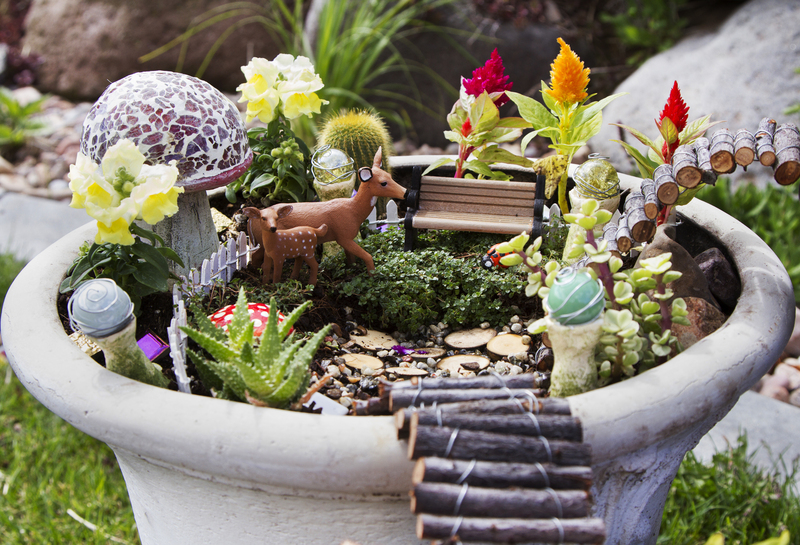Revolutionize Your Garden with Hedge Trimming Styles
Posted on 17/06/2025
Revolutionize Your Garden with Hedge Trimming Styles
Are you looking to breathe new life into your garden? The answer might just be right at your fingertips--literally! Hedge trimming has long been a key component of landscape design, and with creative hedge trimming styles, you can truly transform your outdoor space into a showstopping masterpiece. In this comprehensive article, we'll explore how to revolutionize your garden using inventive and practical hedge trimming techniques, ensuring your garden is both beautiful and the envy of the neighborhood.
Why Hedge Trimming Matters
Hedge cutting isn't just about keeping your greenery tidy; it's about expressing your creativity, boosting curb appeal, and even improving property value. Well-trimmed hedges offer more than aesthetic appeal--they can enhance privacy, reduce noise, and provide a stylish, natural boundary for your property. Understanding how to pick and perfect the right hedge trimming style for your garden can truly make a world of difference.
Key Benefits of Regular Hedge Trimming
- Encourages healthy growth by removing dead or diseased branches
- Enhances plant density, resulting in lush, green foliage
- Improves sunlight penetration and air circulation
- Shapes and defines garden spaces and walkways
- Can help control pests and limit the spread of disease
Let's uncover the different types of hedge trimming styles that can take your garden to the next level.

Popular Hedge Trimming Styles for a Modern Garden
Different gardens call for different aesthetics. Whether you prefer classic lines or playful creativity, there's a hedge trimming style to match every personality and garden layout. Here are the most popular and innovative hedge trimming style options you should consider:
1. Formal Hedges: Elegance in Simplicity
Formal hedge trimming involves precise, geometric shapes. Think straight lines, perfect spheres, and symmetrical rectangles. These styles tend to use evergreen hedge plants such as Buxus sempervirens (boxwood), yew, or privet for a crisp, manicured look. Formal trimming works well for:
- Defining garden boundaries or paths
- Framing entryways
- Creating classic parterre or knot gardens
Pro tip: Regular trims, at least twice a year, keep formal hedges looking sharp and healthy.
2. Informal Hedges: Nature's Elegance
Informal hedge trimming gives a more relaxed, natural shape, allowing plants to grow freely with gentle guidance. This style typically uses flowering shrubs like Forsythia, Hydrangea, or Spiraea for colorful, soft-edged borders. Informal hedges are perfect for:
- Wildflower gardens
- Cottage-style landscapes
- Attracting birds and pollinators
Tip: Trim lightly to remove dead wood and guide the desired shape, rather than create hard lines.
3. Topiary: Artistry Through Hedge Trimming
For those wanting to revolutionize their garden with hedge trimming styles, topiary is the ultimate expression. This living sculpture technique transforms hedges into animals, spirals, cones, or even whimsical objects. Ideal plants include boxwood, holly, and yew, as they respond well to frequent, detailed trims.
- Adds a playful or elegant flair
- Great conversation starters for garden parties
- Can be created as focal points or along paths
Topiary requires patience, but the jaw-dropping results are worth it!
4. Cloud Pruning: Organic Elegance
Cloud pruning is an ancient Japanese practice (niwaki) of shaping hedges and shrubs into rounded, cloud-like forms. This organic, flowing shape blends seamlessly with modern and Zen-inspired gardens. Cloud-pruned hedges are:
- Low maintenance once established
- Stunning among rocks, water features, or gravel
- Perfect for focal points and softening hard edges
5. Layered and Tapered Hedges: Dynamic Visuals
Layered hedge trimming involves planting and shaping hedges in a stepped, tiered formation, often with different plant species. Tapered hedges, where the base is broader than the top, are also popular for:
- Maximizing sunlight to lower leaves
- Creating the illusion of depth and height
- Protecting plants from wind damage
Layered and tapered hedges add unique structure and complexity to your garden design.
Choosing the Best Plants for Your Hedge Trimming Style
To revolutionize your garden with hedge trimming styles, begin by selecting the right plant species to suit your design and climate.
Evergreen Plants: Year-round Beauty
- Boxwood (Buxus sempervirens): Classic, dense foliage; perfect for formal and topiary hedges
- Yew (Taxus baccata): Tolerates heavy shaping and grows slowly, ideal for intricate designs
- Privet (Ligustrum vulgare): Fast-growing, affordable, and adaptable
- Holly (Ilex aquifolium): Gorgeous year-round, with glossy leaves and winter berries
Flowering and Deciduous Shrubs
- Forsythia: Brilliant yellow spring blooms; ideal for informal hedges
- Spiraea: Delicate flowers in spring and summer; likes minimal shaping
- Hydrangea: Large, showy blooms; fantastic in cottage gardens
- Lilac (Syringa): Striking scent and color in late spring
Choose species that thrive in your region's soil and climate. Consult with local nurseries or gardening experts for best results.
The Tools You'll Need for Creative Hedge Trimming
Equipping yourself with the right hedge trimming tools is essential for safety and style precision.
Must-Have Hedge Trimming Equipment
- Hand shears: For small hedges or precision work, especially topiary
- Electric or petrol hedge trimmer: Efficient for medium to large, formal hedges
- Pole trimmer: Reaches tall or wide hedges with ease
- Saw: To tackle thicker branches or neglected hedges
- String lines or templates: For straight lines and geometric patterns
- Protective gear: Gloves, goggles, and ear protection for safety
Pro tip: Always keep your blades sharp! Dull blades can rip through branches, causing plant stress and uneven growth.
Step-by-Step Guide: Achieving Your Desired Hedge Trimming Style
Ready to revolutionize your garden? Follow these essential steps for the perfect hedge transformation:
- Step 1: Plan your design. Visualize or sketch your desired hedge trimming style. Mark out lines with stakes and string as needed.
- Step 2: Choose the right time. Most hedges benefit from trimming in late spring or early summer. Avoid cutting during frost or extreme heat.
- Step 3: Start with clean tools. Use disinfected, sharp blades to avoid introducing disease.
- Step 4: Begin with rough shaping. Remove overgrowth, dead branches, and shape the rough outline.
- Step 5: Refine and define. Work in small sections, stepping back regularly to check for symmetry and consistency.
- Step 6: Maintain your creation. Revisit your hedges every few months to trim new growth and preserve the style.
Remember: Patience and regular care are the foundations of striking, well-shaped hedges!
Creative Ideas to Elevate Your Hedge Trimming Style
- Mix and Match Styles: Experiment with different hedge trimming styles in various parts of your garden. For example, use formal lines for your entrance, and cloud pruning for your backyard retreat.
- Add Color: Incorporate flowering hedges or plant annual borders against evergreen trimmed edges for a pop of color.
- Lighting: Highlight sculpted hedges and topiary with garden lighting to create a magical evening ambiance.
- Seasonal Themes: Change up your trimming pattern each year or holiday (hearts for Valentine's, stars for Christmas) for added charm.
- Functional Design: Use hedges to create secret nooks, mazes, or screens for privacy and outdoor entertaining.
Common Mistakes to Avoid with Hedge Trimming Styles
Even with the best intentions, it's easy to stumble when trying new hedge shaping ideas. Watch out for these common pitfalls:
- Over-pruning: Cutting too much at once weakens plants and may result in brown patches, particularly in slow-growing hedges.
- Ignoring plant needs: Some shrubs respond to trimming differently, so check growth habits before shaping aggressively.
- Neglecting the base: Taper hedges wider at the bottom to ensure sunlight reaches all leaves--prevents thinning and dieback near the soil.
- Skipping maintenance: Letting your masterpiece grow wild can undo months of effort. Schedule regular shaping and inspections.
- Forgetting safety: Wear proper attire, and avoid using power tools in bad weather. Seek help for tall or challenging hedges.
Maintenance Tips for Long-Lasting Hedge Trimming Styles
- Feed and water: Healthy plants respond best to trimming. Use mulch and compost, and water during drought.
- Inspect for pests: Trimmed hedges hide fewer pest problems, but inspect leaves regularly and address pests immediately.
- Keep edges clean: After trimming, remove all fallen debris to avoid disease and maintain a polished look.

How Frequently Should You Trim for Stunning Hedge Designs?
The answer depends on the species and the hedge trimming technique you choose. Here's a quick guideline:
- Formal and topiary hedges: Every 4-8 weeks during growing season.
- Informal flowering hedges: Once after flowering, and light trims as needed.
- Slow-growing evergreens: 1-2 times per year, generally late spring and late summer.
Consistency is the key to healthy, well-shaped hedges no matter what style you select!
Revolutionize Your Garden: Transform Today!
Updating your garden with diverse hedge trimming styles is more than just an aesthetic upgrade--it's a way to showcase your personality, boost property value, and create a unique outdoor sanctuary. Whether you're a fan of classic formal lines or daring topiary shapes, creative hedge trimming enables any homeowner to play the role of landscape artist.
Start planning your garden transformation today!
- Assess your space and choose the hedge trimming technique that expresses your style.
- Select the right plant types for your chosen style and climate.
- Gather quality tools and mark your trimming calendar for regular maintenance.
- Don't be afraid to start small and master your technique before tackling complex designs.
With a little practice and inspiration, creative hedge trimming will make your garden stand out and evolve with each season. Revolutionize your outdoor space--one trim at a time!
Master the art of hedge design, and you'll turn every visitor's head while enjoying a garden that's unique, lively, and full of character. Happy trimming!

